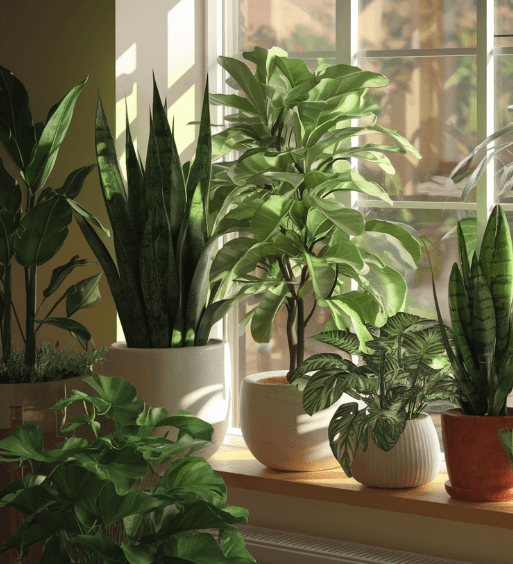Introduction to Indoor Houseplant Care
Table of Contents
The Benefits of Growing Houseplants
I will never forget when my Aunt Maria handed me a small spider plant in a simple clay pot. She smiled and said, “This plant will teach you patience.” At the time, I laughed, not understanding what she meant. But as the weeks passed, I checked the tiny leaves daily, eager to see new growth. Watching it flourish under my care, I realized that nurturing a plant wasn’t just about water—it was about observation, consistency, and a little bit of love.
Houseplants do more than just beautify a home. They improve air quality by absorbing toxins and increasing humidity levels. Studies suggest that certain plants, like the best indoor houseplants for beginners, can help reduce stress and boost productivity. A well-maintained indoor plant collection can even enhance mental well-being by fostering a connection with nature.
Another major benefit is their ability to purify air. Research by NASA’s Clean Air Study suggests that multiple plants can remove harmful chemicals like benzene and formaldehyde from indoor environments. If you are wondering, “How many houseplants do you need to clean the air?”, experts recommend at least one plant per 100 square feet.

Understanding the Basics of Houseplant Care
Caring for houseplants is an art and a science. Each plant has unique requirements, but understanding houseplant light requirements, proper watering techniques, and the right potting mix ensures a thriving indoor garden.
Some plants, like snake plants and ZZ plants, tolerate neglect, making them beginner-friendly houseplants. Others, such as fiddle-leaf figs, demand more attention and strict conditions.
The essentials of indoor plant maintenance include:
- Ensuring adequate sunlight exposure
- Following a consistent watering schedule
- Using the best soil for indoor plants
- Monitoring humidity and temperature
- Preventing pests and diseases
Let us explore each aspect in detail to help you cultivate a thriving indoor garden.
Selecting the Right Indoor Plants
Best Indoor Houseplants for Beginners
If you’re just starting with indoor gardening, choose hardy plants that need little maintenance.
The best indoor houseplants for beginners include:
- Snake Plant (Sansevieria) – Tolerates low light and irregular watering.
- Pothos (Epipremnum aureum) – Thrives in various conditions and purifies the air.
- Spider Plant (Chlorophytum comosum) – Easy to grow and great for air purification.
- ZZ Plant (Zamioculcas zamiifolia) – Thrives in low light and tolerates drought with ease.
- Peace Lily (Spathiphyllum) – Adds beauty and removes toxins from the air.
Factors to Consider When Choosing Houseplants
Selecting the right indoor plant depends on several factors:
- Light conditions – Some plants require bright, indirect light, while others thrive in shade.
- Humidity and temperature – Tropical plants need higher humidity, whereas succulents prefer dry air.
- Maintenance level – If you travel often, opt for low-maintenance plants.
- Pet safety – Some plants, like pothos and philodendrons, are toxic to pets.
- Aesthetic appeal – Select plants that enhance your home’s decor.
Popular Low-Maintenance Houseplants
For those with a busy lifestyle, these low-light indoor plants require little attention:
- Cast Iron Plant (Aspidistra elatior) – Extremely resilient and hard to kill.
- Aloe Vera – Needs occasional watering and bright light.
- Rubber Plant (Ficus elastica) – Hardy and stylish.
- Dracaena – Requires minimal watering and indirect sunlight.
Essential Elements of Houseplant Care
Light Requirements for Indoor Plants
Understanding houseplant light requirements is crucial. Most indoor plants prefer bright, indirect light, but some adapt to low-light conditions. Here arethe different light categories:
- Low light: Snake plants, ZZ plants
- Medium-light: Peace lilies, pothos
- Bright indirect light: Fiddle-leaf figs, monsteras
- Direct sunlight: Succulents, cacti

Watering Techniques and Schedules
Overwatering is a common mistake. Follow these guidelines:
- Check soil moisture before watering.
- Use pots with drainage holes.
- Adjust the watering frequency based on the seasons.
- Houseplant watering schedule: Most plants require watering about once a week.
Soil and Potting Mix Selection
Using the best soil for indoor plants ensures healthy root growth. Choose well-draining soil tailored to specific plant types:
- Succulents – Sandy, well-aerated mix
- Orchids – Bark-based mix
- Ferns – Moist, rich organic soil
Humidity and Temperature Control
Indoor plants thrive in 40–60% humidity. To maintain proper humidity levels:
- Use a pebble tray or humidifier.
- Group plants together.
- Avoid placing plants near vents.
Fertilizing Indoor Plants
Apply indoor plant fertilizer every 4–6 weeks. For healthier growth, use organic options like compost tea or slow-release granules.
Common Challenges in Houseplant Care
Identifying and Managing Pests
Typical pests consist of spider mites, aphids, and fungus gnats. Prevent infestations by:
- Regularly inspecting leaves.
- Wiping leaves with neem oil.
- Avoiding overwatering.
Recognizing and Treating Diseases
Houseplants are prone to root rot, powdery mildew, and bacterial leaf spots. Combat these by improving airflow, avoiding excess moisture, and using fungicides.
Troubleshooting Common Houseplant Problems
- Yellow leaves? Overwatering or nutrient deficiency.
- Brown tips? Low humidity or excessive salts.
- Drooping foliage? Underwatering or root-bound conditions.

Advanced Houseplant Care Tips
Pruning and Repotting Techniques
- Remove dead or damaged leaves.
- Repot plants every 1–2 years.
- Use fresh soil to prevent nutrient depletion.
Propagation Methods for Indoor Plants
- Stem cuttings: Pothos, snake plants
- Leaf cuttings: African violets, succulents
- Division: Snake plants, peace lilies
Frequently Asked Questions (FAQs) About Indoor Houseplant Care
What are the best indoor houseplants for beginners?
See Part 2 for details on beginner-friendly plants.
How many houseplants do you need to clean the air?
Experts suggest at least one plant per 100 square feet.
Which houseplant is the most difficult to maintain?
Fiddle-leaf figs are notoriously finicky due to their strict light and watering needs.
How many hours of light do indoor plants need?
Most plants require 6–12 hours of indirect light daily.
Conclusion
Recap of Key Points in Houseplant Care
Indoor plants enhance home aesthetics, improve air quality, and provide therapeutic benefits. Mastering indoor plant maintenance involves proper watering, lighting, and pest control.
Encouragement for Ongoing Learning and Experimentation
Gardening is a journey. Experiment with different plants, learn from mistakes, and enjoy the process of nurturing your indoor garden.

1 thought on “Indoor Houseplant Care 101: A Complete Beginner’s Guide”